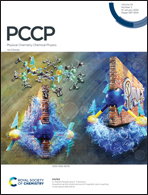First principles calculations on lithium diffusion near the surface and in the bulk of Fe-doped LiCoPO4†
Abstract
The olivine phosphate LiCoPO4 is a prospective cathode material in high-voltage lithium-ion batteries. During lithium diffusion, the ions must overcome the diffusion energy barrier near the surface and in the bulk. Experimental studies have shown that Fe doping can enhance the electrochemical performance of LiCoPO4 with a doping concentration of x = 0.2 (LiFe0.2Co0.8PO4). DFT calculations can provide detailed understanding of the lithium diffusion mechanism, structural stability, and electronic properties for Fe-doped LiCoPO4 and elucidate the origins for this improvement from a microscopic viewpoint. In this study, the electronic structure of Fe-doped LiCoPO4 was calculated via first principles and compared with that of pristine LiCoPO4. To investigate the surface properties of LiCoPO4, surface energies with low indices were calculated. The results showed that the (010) surface has the lowest surface energy. Minimum energy diffusion pathways and energy barriers were calculated using the NEB method. Our calculations showed that the energy barrier for lithium-ion diffusion can be reduced by Fe doping modification. Furthermore, we investigated the diffusion processes of polarons and lithium ions migrating simultaneously. This study has implications for further application of LiCoPO4 as a cathode material.



 Please wait while we load your content...
Please wait while we load your content...